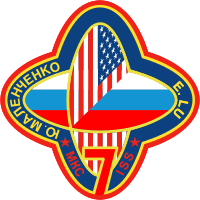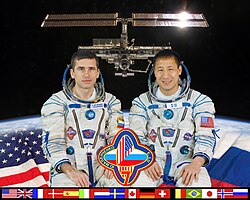ISS expedition 7
| Mission emblem | |||
|---|---|---|---|

|
|||
| Mission dates | |||
| Mission: | ISS expedition 7 | ||
| Crew: | 2 | ||
| Rescue ships: | Soyuz TMA-2 | ||
| Space station: | ISS | ||
| Start: | April 28, 2003, 05:56 UTC | ||
| Started by: | Coupling of Soyuz TMA-2 | ||
| The End: | October 27, 2003, 23:17 UTC | ||
| Ended by: | Decoupling from Soyuz TMA-2 | ||
| Duration: | 182d 17h 21min | ||
| Team photo | |||
 (from left) Juri Malentschenko and Edward Tsang Lu
|
|||
| navigation | |||
|
|||
ISS Expedition 7 is the mission name for the seventh long-term crew of the International Space Station . The crew lived and worked on board the ISS from April 28, 2003 to October 27, 2003.
team
- Yuri Ivanovich Malenchenko (3rd space flight), ISS commander May 3 to October 24, 2003 ( Roskosmos / Russia )
- Edward Tsang Lu (3rd space flight), flight engineer ( NASA / USA )
Originally, the team should consist of three people. Sergei Moschtschenko was initially scheduled to be the flight engineer, but he was replaced by Alexander Kaleri in December 2002 . After the accident on the space shuttle Columbia in February 2003, the crew was reduced to two people.
Substitute team
The later crew of the ISS expedition 8 , but with reversed roles:
- Alexander Jurjewitsch Kaleri , Commander (Roskosmos / Russia)
- Colin Michael Foale , flight engineer (NASA / USA)
Mission description
The original plan was to bring a crew of three to the ISS with STS-114 . After the accident on the Columbia space shuttle in February 2003, space shuttle flights were temporarily suspended. In order to save resources, all of the following permanent crews were reduced to two people and all feeder flights were carried out by Soyuz rocket .
The seventh crew of the International Space Station took off on April 25, 2003 in the Soyuz TMA-2 spacecraft from the Russian space center Baikonur in Kazakhstan . It docked on April 28, 2003, and five days later the crew took command of the ISS.
The main task of the new crew was to keep the station in function and to continue some long-term research. The crew was supplied by unmanned, automatic Progress transporters. With their propulsion system, the orbit of the International Space Station was also raised at irregular intervals.
After the handover of the station, which took several days, routine work began. The scientific program, which was reduced due to the limited supply and the almost complete lack of return transport options, included experiments in medicine, earth observation, biology, materials science and space technology. Investigations on natural and man-made phenomena on earth and in the earth's atmosphere (experiments: Crew Earth Observation , ESTER , Biotomea , Uragan , Molnija SM ), on structures on the earth's surface by remote control of a station camera by groups of pupils on the Earth (EarthKAM) , for cooperation between station and ground crew (crew interactions) , for radiation and acceleration measurements within the station (Radiation Monitoring, Prognoz, BraDoz, MAMS, SAMS) as well as various material tests (Kromka, MPAC, SEED, MISSE, Meteoroid ) . Hundreds of different material samples are attached to the outside of the station. The samples are changed at longer intervals. The test of a system for the use of a global time signal (Global Time System) , the recording of the station's movement parameters as well as the test of forecast systems (Tenzor, Vektor T, Izgib) and the search for heavy solar and galactic nuclei (Platan) also ran without supervision . An extensive complex dealt with the effects of weightlessness, radiation and the special biological environmental values within the station on living organisms (Biorisk, Konjugazija) and especially on plants ( Rastenija 2 in the Lada greenhouse). Medical data on muscle and bone changes, effects on the circulatory and immune systems, etc. The like were collected partly during the flight, but mostly before and after the stay in space ( Sprut-MBI, Parodont, Farma, Kardio-ODNT, Profilaktika, Pulse, Gematologia, MION, Isokinez, Tendometria, Biopsy, etc.). Material experiments dealt, for example, with the growth of protein crystals (PCG-STES, ZCG) , with the behavior of magnetic particles in magnetorheological fluids (new, "intelligent" fluids with controllable magnetism) in weightlessness (InSpace) or with the formation of bubbles in solidifying ones Melting (PFMI) .
In Star Mail focused on the exchange of imaged electronic messages of spaceman with their families and friends. Diurez dealt with the metabolism of liquid electrolytes in the body and the influence of hormonal changes on blood volume, Biotest with the biochemical mechanisms of metabolic adaptation to the environment. The Pilot experiment investigated individual characteristics of the psychophysiological regulation of space travelers during long-term flights. Meschkletochnoje Wsaimodeistwije dealt with the study of cell surfaces and intercellular interactions in weightlessness, Konjugatsija changes in the genetic material of bacteria and MSC the development of stem cells in weightlessness. Roundworms of the species Caenorhabditis elegans were also examined (experiment CEMMS ). They have a short life cycle. Therefore, long-term changes can be identified more quickly in them. Another object of investigation was Streptococcus pneumoniae (SPEGIS) . Here, the scientists were particularly interested in whether the dangerousness of bacteria changes in weightlessness through genetic adaptations. S. pneumoniae can cause pneumonia , sinus infections, and chronic bronchitis . Most people already carry the bacterium, but only a weakened immune system can cause lung infections. Post-flight medical examinations also included thermography of the arms and legs to control the function of thermoregulation while adjusting to gravity. Further experiments were devoted to the movements of the smallest particles in electrical fields under excitation by electromagnetic waves (plasma crystal experiment 3) and the stability of solid-liquid mixtures depending on the "grain size" of the solid substance (coarsening in solid liquid mixtures) . New to the program were test operations with the station's manipulator arm, during which cameras were calibrated for future examinations of the heat shield of docked space shuttles.
The program also included dry runs for an extraterrestrial mission, without the support of a third crew member remaining in the station, and frequent press conferences and discussions with students around the world. On May 30, the station carried out an evasive maneuver. The orbit was raised by 1.8 km so as not to get too close to the MEGSAT satellite. It was only the sixth maneuver of its kind.
On June 11, the Progress-M1 10 spacecraft docked with the station's Pirs module. With him came food, spare parts, water, clothing, office supplies and experiments for the ESA mission in autumn. Progress-M 48 docked on August 31 (start on August 28) with fuel, water and supplies at the stern of the station after Progress-M 47 had been disconnected three days earlier. It was followed by Progress-M1 10 on September 4th. Both transport spaceships were laden with waste and burned up in the earth's atmosphere.
During this mission, Yuri Malenchenko married his wife Yekaterina on August 10, 2003. It was video-linked to the Johnson Space Center (JSC) auditorium in Houston , where the ceremony was being conducted. Ed Lu acted as best man and played the wedding march on a keyboard.
On October 20, 2003, Soyuz TMA-3, the first manned spacecraft since the arrival of Malenchenko and Lu, docked with the ISS. The next long-term crew , consisting of Michael Foale and Alexander Kaleri, was on board . In addition, was ESA -Astronaut Pedro Duque on board.
Malenchenko and Lu landed together with Pedro Duque in Kazakhstan on October 28, 2003 , after a little more than six months in space.
The seventh ISS expedition did not have space missions .
See also
Web links
- NASA: mission page
- NASA: EC7 Image Gallery
- raumfahrer.net: Expedition report
Individual evidence
- ↑ a b NASA Names 23 Astronauts and Cosmonauts to Shuttle Flights in 2002. NASA, August 17, 2001, accessed on April 21, 2009 (English).
- ↑ Expedition Five crew members Backup Named To Expedition Seven. NASA, December 3, 2002, accessed April 21, 2009 .
